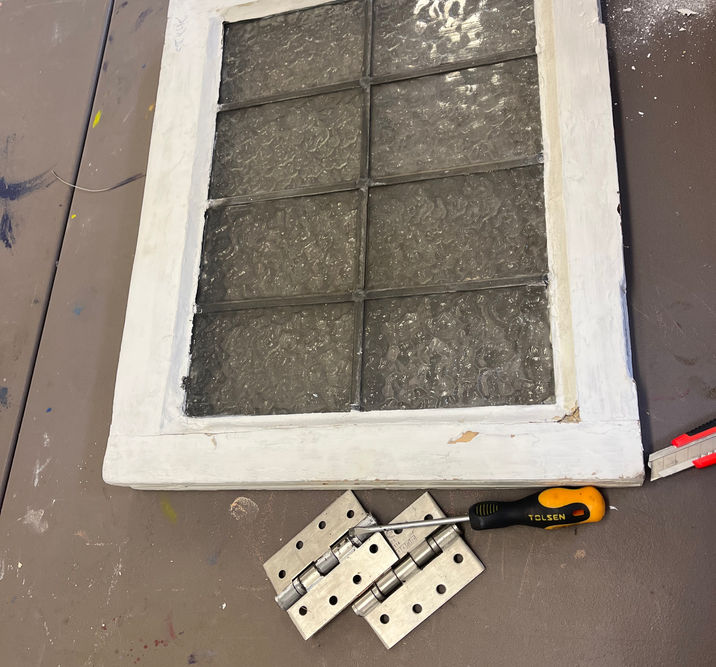Documentation
Following the Copland exhibition, I took time to reflect on my current work, looking for ways to enhance and further develop it.
Much of my previous practice in this unit has been inspired by Gaston Bachelard's The Poetics of Space. Building on this foundation, I decided to conduct further experiments to deepen and expand upon the insights I had gained
1. Drawer
Bachelard’s conception of drawers, chests, and cabinets as inner spaces highlights their role as containers for hidden things—the secret places of the human heart. The poet engages with these spaces through imagination and dreams. Rather than just static storage for objects, these inner spaces are akin to infinite black holes that hold memories and secrets, essential to understanding the consciousness of the individual. These containers represent more than physical objects; they hold the intangible aspects of human experience.
I recognize the author's focus on how the inner world is viewed from the outside, inviting us to imagine what lies within. By linking this concept to memory, imagination, and secrets, the imagery offers a powerful metaphor. In my own work, I find the drawer particularly significant as I explore the relationship between private space, intimacy, and objects. On both an experiential and psychological level, the nightstand drawer represents a corner of intimacy, privacy, and identity. It is where people store personal and everyday items, and the way these objects are arranged reflects their personalities and habits. This bedside drawer, therefore, becomes a focal point in my exploration of how objects and psychological spaces connect to create a sense of intimacy.
(Work in progress)






Reflection
I continued using my previous shooting methods, which involved studio photography and postproduction techniques to isolate the central object in the frame against a backdrop of pure whiteness. For the drawer subjects, I selected peers who, like me, had recently moved to London. I photographed them in two distinct ways:
1.Focusing on a single, most significant object from the drawer.
2.Documenting the original, unorganized state of the drawer, then recreating it in the studio for further documentation.
Both approaches, I believe, reveal aspects of the individual’s identity—whether through a symbolic portrayal in the first method or a more documentary-style representation in the second.
I noticed something interesting about the presentation of my single item: it feels more like using the outline of a drawer rather than a conventional photo frame. According to previous experience, the way a photograph is mounted can evoke a different atmosphere compared to traditional framing. Much like the choice between viewing a photograph on a screen or printing it on carefully selected paper, framing adds a sculptural dimension to the image, introducing new layers of narrative and meaning.
Examples from other artist:






Works From Other Artist (unknown name) Instagram
@sustainablesyrup
2. Stain
Building on my previous experiment, I continued exploring objects that reflect personal behavior and identity. I shifted my focusing on the bathroom and noticed that the water stains and daily marks left on various objects serve as traces of my existence in that space. These stains reflect my presence and document the behaviors and routines that have shaped the environment. Romantically speaking, they are like drawings made by my body, habits, experiences and unconsciousness. To explore this idea further, I brought the sink's load-bearing plate into the studio, photographing it with the water stains, toothpaste marks, and stickers from toiletries. I also documented the shapes of the water stains that had accumulated over time in the bathroom.
Work in Progress
Reflection
After these attempts, I find myself at a crossroads again, as the current works still feel incomplete and fragmented. My goal was to reveal the subtle connections that define the dynamic relationship between personal experiences and spaces. However, "space" is a broad concept. Given the limited time before the summer exhibition, I’ve decided to narrow my focus to the home—specifically, intimate spaces—since that is where my current experiments and practices have taken place. My broader interest remains in exploring the intricate relationship between space, objects, and ourselves, particularly how the material qualities of objects—serving as a middle point between space and us—both influence and are influenced by our presence.
Reflecting on my previous thoughts, I feel a need to change the framing of my work to better express my theme. I was inspired by children’s sketches, which often prominently feature windows and doors. Psychologically, it is argued that when children draw something as abstract as a home, they express their innermost feelings about it. After examining numerous children's drawings, I noticed that regardless of the complexity or simplicity of the elements depicted, there is always a door and a window. This observation resonates with Gaston Bachelard’s insights in The Poetics of Space regarding these two elements.
3. Window
Motivated by this idea, I decided to frame my photographs within a canvas-like white art gallery setting that incorporates the visual motifs of doors and windows, aiming to create a meaningful connection between them. One of my initial concepts was to frame my previous scenic photographs with window imagery.
Using windows as frames unifies the photographs to some extent, enriching the narrative against a pure white background. This approach addresses the challenge of analyzing the previous photographs individually. With this direction in mind, I began selecting and testing materials for the new presentation.
Work in Progress





Final Result
4. Door
When it came to the element of doors, I initially approached the theme by photographing various doors in my neighborhood and collecting images of the doors around the area where I lived.

Work in Progress
Ultimately, I realized that the doors I had photographed were aesthetically appropriate but lacked a deep connection to my personal experiences. None of the results resonated with me, prompting reflection on my own relationship with doors as a way to move forward in this part of my development. A door serves as a boundary; it delineates the private from the public and distinguishes the intimate from the unfamiliar. The very existence of a door allows us to define a space, and the notion of belonging gives rise to this concept.
In my quest to connect the door to the idea of home from a more personal and emotional perspective, I reflected on my upbringing and family atmosphere. One of my most vivid memories is from my childhood in a three-person family, where we spent only brief moments together in the living room after dinner before retreating to our separate rooms—my parents even lived apart due to emotional issues. When I would venture into the living room to get a glass of water, I often encountered a darkened room illuminated only by the light from three bedroom doors. This light symbolizes the door as a boundary that separates the private from the public. Similar to the earlier discussion of the drawer, this light offers a glimpse into a private, unseen life, while also provoking the imagination. I realized in my practice the light is the essence of the door.



































